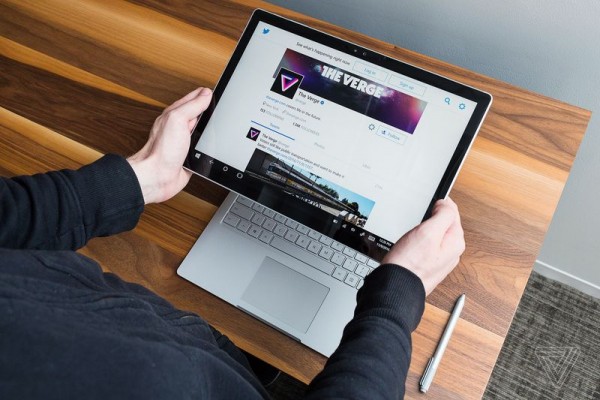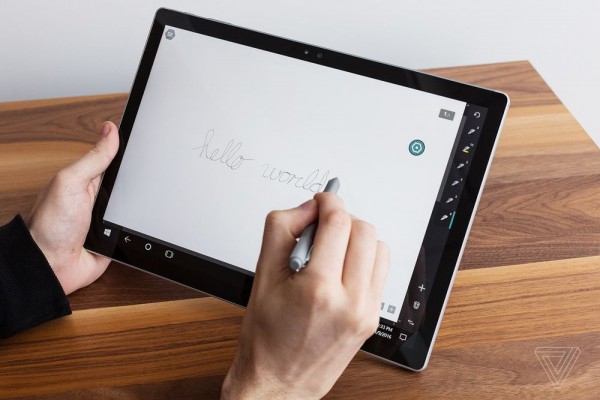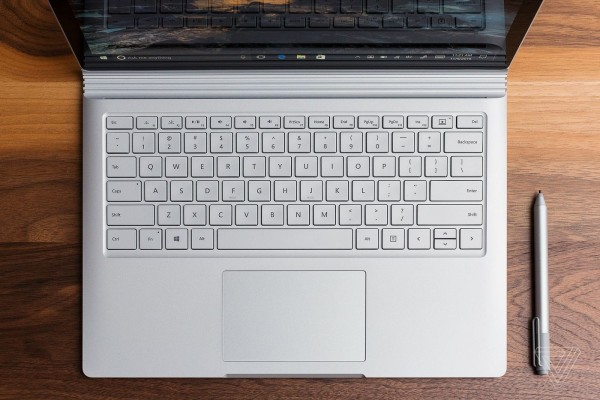ear ago, Microsoft set out to prove to the world that a Windows laptop could hang with the best MacBooks from Apple. The Surface Book, with its head-turning design, wild hinge technology, and detachable screen was just that laptop. Microsoft largely succeeded: though it wasn’t perfect, the Surface Book showed that a powerful, well-designed, and attractive Windows laptop was possible.
A year later, the company hasn’t changed much with the Surface Book formula, not that it really had to. In fact, most of the Surface Book line is entirely unchanged: the only update is happening to the top-of-the-line model, while everything else remains the same. If you’ve been hoping for a Surface Book 2, this is not the machine you’ve been waiting for.
The new, king-of-the-hill Surface Book is $100 more than last year’s model (a hefty $2,399 for 8GB of RAM and a 256GB SSD; $2,799 for one with 16GB of RAM and a 512GB SSD; or an even heftier $3,299 for 16GB of RAM and a 1TB SSD) and has the same sixth-generation Intel Core i7 processor; same 13.5-inch “PixelSense” display with 3000 x 2000 pixels of resolution; same Surface Pen capabilities; same port selection (two USB-A 3.0 ports, an SD card slot, a DisplayPort, a headphone jack, and power); and the same capability to turn into a tablet in a pinch. Microsoft has only made two internal changes: the graphics processor has been bumped up to a Nvidia GeForce GTX 965M with 2GB GDDR5 memory and the battery has been increased in capacity to provide an estimated 16 hours of stamina, four hours more than last year’s model.
Those two changes are minor in the long list of Surface Book specs, but they forced Microsoft to adjust the base of the Surface Book to accommodate them. The new Performance Base (the one that comes with the high-end Book and houses the discrete graphics card) is thicker and heavier than last year’s, pushing the already sizeable laptop’s weight up to 3.6 pounds. The extra thickness helps to minimize — but not fully eliminate — the dreaded lint-collecting gap that forms when the laptop is closed. The Book was not the slimmest nor lightest laptop you could get, and these changes only make it more substantial — this is a beefy 13-inch laptop by any definition.
I’ve been using the new Surface Book as my main machine for the past week and despite those changes, the experience is mostly the same as last year’s version. Part of that is due to my workflow — Adobe Photoshop and Lightroom are the heaviest apps I use, and they pose no challenge to this level of machine — but most of the reason the experience is the same is because Microsoft just didn’t change much. Microsoft says it increased the graphical performance of the high-end Surface Book in response to customer demands, so it might be noticeable to someone, but it’s not to me.

Microsoft does not advertise the Book as a gaming machine, but its new graphics card is capable of handling some lightweight gaming. But if you’re going to spend this much money on a laptop and are a serious gamer, there are much better options available to you, including ones that have the latest chips from Nvidia and can support VR (the Surface Book cannot, at least when it comes to powering the HTC Vive or Oculus Rift).
Also missed on me is the increased battery life. In our rundown test, the Surface Book lasted 10 hours and 21 minutes, which is quite good. But in my real-world usage, browsing the web, jumping between a half-dozen apps, writing email, monitoring social feeds, etc., it struggled to last a full work day before calling it quits. Most days, the Surface Book would last between six and eight hours, which is about average for a laptop of this size. (Using the Book as a tablet worked for about two hours before it died, which is unchanged from last year.) That’s a far cry from Microsoft’s claimed 16 hours and less than my colleague Vlad Savov could get with the new 13-inch MacBook Pro. Fortunately, this Surface Book has no issues going to sleep when it’s closed and in my bag, which is a problem I’ve encountered with numerous Windows 10 laptops over the past year.
Otherwise, the new Surface Book is a joy to use. The powerful processor and copious RAM let me switch between apps with ease, load dozens of tabs in my browser, and process images speedily, while never really having to wait for anything. The keyboard is wonderful to type on, and the large trackpad is the best you can get on a Windows machine. And it actually works well on my lap: I used the Surface Book numerous times on my commute without worrying that it would slide off my lap. It’s not entirely rational, and this Surface Book is certainly way more computer than I need to do my job, but I just like working on it.
There are a couple of things I do wish Microsoft had added for this update, though. I appreciate the SD card slot and full-size USB ports, but it would have been great if Microsoft added at least one USB Type-C port, since I’m already using a phone and other accessories that rely on it. And while the hinge has been slightly modified to accommodate the larger base, it still doesn’t flex back as much as I’d like, making it awkward when using the Surface Book at a standing desk.
Others might lament the fact that the processor hasn’t changed and Microsoft isn’t using Intel’s new Kaby Lake chips. (This is a common complaint with Apple’s new MacBook Pro, as well.) Or you might not like that you can’t get more than 16GB of RAM in the new Book, even if you max out all of the specs. (This, too, is a common complaint with the new MacBook Pro.) Or you might wish that Microsoft had gone all the way up to Nvidia’s GTX 1060 graphics card, like Razer did with its new Blade. (Also a frequently cited complaint with the MacBook Pro.)
If you were hoping that this new Surface Book would be a complete overhaul, you’ll have to keep waiting. It is quite truly a midlife cycle spec refresh and nothing more. Most people will probably be just fine with one of the less expensive Surface Books, which haven’t been updated, but if you want to pony up to the top of the line, that top is slightly higher than before.
The question now is do you plunk down $3,000 for this ultimate Surface Book, or do you wait for the inevitable Surface Book 2 that will likely come next year? If you have a Surface Book already, it doesn’t make much sense to upgrade this soon into its lifespan. And there is certainly a good argument to be made to wait for the Microsoft’s next revision, which will likely have Intel’s seventh-generation processor.
But if you can’t wait, and you’re looking for the ultimate Windows laptop, it’s hard to look past Microsoft’s latest Surface Book.
Correction, 11:10 AM ET, November 10th, 2016: An earlier version of this review mistakenly referred to the Surface Book’s processor as quad-core. It’s a dual-core processor. The error has been corrected.






